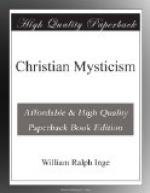FOOTNOTES:
[Footnote 316: In R.L. Nettleship’s Remains.]
[Footnote 317: In addition to passages quoted elsewhere, the following sentence from Luthardt is a good statement of the symbolic theory: “Nature is a world of symbolism, a rich hieroglyphic book: everything visible conceals an invisible mystery, and the last mystery of all is God.” Goethe’s “Alles vergaengliche ist nur ein Gleichniss” would be better without the “nur,” from our point of view.]
[Footnote 318: Recejac, Essai sur les Fondements de la Connaissance Mystique.]
[Footnote 319: In the Edinburgh Review, October 1896. The article referred to, on “The Catholic Mystics of the Middle Ages,” is beautifully written, and should be read by all who are interested in the subject.]
[Footnote 320: This is Kant’s use of the word. See Bosanquet, History of AEsthetic, p. 273: “A symbol is for Kant a perception or presentation which represents a conception neither conventionally as a mere sign, nor directly, but in the abstract, as a scheme, but indirectly though appropriately through a similarity between the rules which govern our reflection in the symbol and in the thing (or idea) symbolised.” “In this sense beauty is a symbol of the moral order.” Goethe’s definition is also valuable: “That is true symbolism where the more particular represents the more general, not as a dream or shade, but as a vivid, instantaneous revelation of the inscrutable.”]




